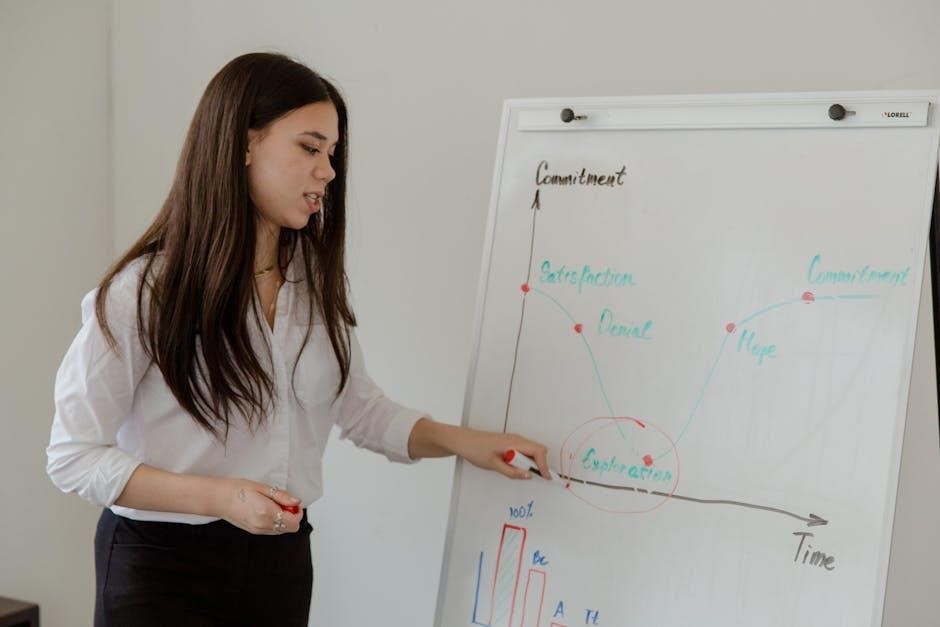Business law is a comprehensive legal field governing commercial activities, ensuring compliance with regulations and minimizing risks. It covers contracts, torts, employment, and intellectual property, essential for smooth business operations.
1.1 Definition and Scope of Business Law
Business law refers to the body of rules and regulations governing commercial activities, ensuring legal compliance and fairness in business operations. It encompasses various legal disciplines, including contracts, torts, employment law, and intellectual property. The scope of business law extends to all forms of business entities, such as corporations, partnerships, and sole proprietorships. It provides a framework for resolving disputes, protecting rights, and maintaining order in the marketplace. Understanding business law is crucial for businesses to operate smoothly, avoid legal pitfalls, and adapt to evolving regulatory environments. Its application is universal, impacting both domestic and international commercial activities.
1.2 Importance of Business Law in Commercial Activities
Business law plays a vital role in ensuring fair and lawful commercial activities. It provides a framework for businesses to operate within legal boundaries, minimizing risks and protecting against liabilities. By adhering to business law, companies can avoid legal disputes, maintain compliance with regulations, and uphold ethical standards. It also safeguards the rights of stakeholders, including employees, customers, and shareholders. Understanding business law is essential for entrepreneurs and organizations to navigate the complexities of the marketplace, ensuring sustainable growth and long-term success. Its importance extends to fostering trust and stability in business relationships and transactions.
1.3 Key Disciplines Within Business Law
Business law encompasses several key disciplines that are essential for understanding its scope and application. These include contract law, which governs agreements between parties, and tort law, addressing civil wrongs like negligence. Employment law regulates workplace relationships, ensuring fair labor practices and anti-discrimination standards. Intellectual property law protects innovations, trademarks, and copyrights, while corporate law focuses on the formation and governance of businesses. Additionally, areas like tax law, bankruptcy law, and international law play crucial roles in shaping business operations and compliance. These disciplines collectively provide a framework for legal and ethical business conduct.
Contracts and Agreements
Contracts and agreements are fundamental to business law, outlining obligations and protecting rights. They ensure clarity and enforceability in commercial transactions, forming the backbone of legal business operations.
2.1 Formation and Essentials of a Valid Contract
A valid contract requires several key elements: offer, acceptance, consideration, legal intent, and capacity. The offer must be clear and definite, while acceptance must be unqualified and communicated. Consideration involves a mutual exchange of value, ensuring fairness. Legal intent means parties must intend to create a binding agreement. Capacity requires all parties to be legally competent. Additionally, contracts for certain matters, like real estate, must be in writing. These elements ensure a contract is enforceable and protects all parties involved, preventing disputes and ensuring clarity in obligations.
2.2 Types of Contracts in Business Law
Contracts in business law vary based on their enforceability, terms, and purpose. Bilateral and unilateral contracts differ in obligations: bilateral requires mutual promises, while unilateral involves one party’s performance. Executory contracts are pending performance, while executed contracts have been fulfilled. Contracts can also be classified as valid, void, or voidable based on their enforceability. Specific types include sales contracts, service contracts, and employment contracts. Each type serves distinct business needs, ensuring clarity and legal protection for all parties involved. Understanding these distinctions is crucial for drafting and enforcing agreements effectively in commercial settings.
2.3 Breach of Contract and Remedies
A breach of contract occurs when one party fails to fulfill their obligations, either partially or entirely. This can be a material breach, significantly impacting the agreement, or a minor breach, with lesser consequences. Remedies for breach include damages to compensate for losses, specific performance to enforce the agreement, or rescission to cancel the contract. In some cases, parties may negotiate a settlement or seek arbitration. Understanding these remedies is crucial for resolving disputes and maintaining business relationships. The goal is to restore the injured party and deter future breaches, ensuring fairness and accountability in commercial dealings.

Tort Law and Strict Liability

Tort law addresses civil wrongs causing harm, while strict liability holds businesses accountable for certain actions, regardless of intent, ensuring legal responsibility and protecting rights.
3.1 Definition and Types of Torts
Torts are civil wrongs causing harm to individuals or property, distinct from criminal offenses. They include intentional torts, such as assault or fraud, and negligent torts, involving a breach of duty. Strict liability torts hold businesses responsible regardless of intent, often in product liability cases. Torts aim to compensate victims and deter future wrongdoing, playing a crucial role in protecting rights and maintaining justice in both personal and commercial contexts.
3.2 Negligence and Liability in Business Contexts
Negligence occurs when a business fails to meet a standard of care, causing harm to others. To establish negligence, plaintiffs must prove duty, breach, causation, and damages. Businesses may face liability for negligence in areas like workplace safety or product defects. Liability can result in legal action, financial penalties, or reputational damage. Understanding negligence is crucial for businesses to implement safeguards, minimize risks, and ensure compliance with legal standards, ultimately protecting stakeholders and maintaining operational integrity.
3.3 Strict Liability and Its Implications for Businesses
Strict liability holds businesses legally responsible for certain actions or products, regardless of intent or negligence. This doctrine often applies to inherently dangerous activities or defective products. Businesses must ensure compliance with safety standards and regulations to avoid liability. Strict liability can lead to significant financial penalties and reputational damage. Companies should implement robust quality control measures and liability insurance to mitigate risks. Understanding strict liability is crucial for businesses to operate ethically and legally, protecting both consumers and their own interests in the marketplace.

Employment Law
Employment law governs workplace relationships, ensuring fair treatment, safety, and compliance with labor standards. It addresses anti-discrimination, wages, and termination, protecting both employers and employees.
4.1 Legal Framework Governing Employer-Employee Relationships
The legal framework governing employer-employee relationships is established through statutes, regulations, and contractual agreements. It defines rights, duties, and obligations, ensuring fairness and compliance. Key areas include employment contracts, workplace safety standards, and anti-discrimination laws. This framework balances employer interests with employee protections, fostering a structured and lawful work environment. It also addresses issues like wages, working hours, and termination procedures, ensuring both parties operate within legal boundaries. Compliance with this framework is essential for maintaining lawful and productive employer-employee dynamics.
4.2 Anti-Discrimination Laws in the Workplace
Anti-discrimination laws protect employees from unfair treatment based on race, gender, age, religion, disability, or other protected characteristics. These laws, such as Title VII of the Civil Rights Act, prohibit bias in hiring, promotion, and termination. Employers must ensure equal opportunities and maintain a workplace free from harassment. Violations can result in legal penalties and reputational damage. Compliance requires clear policies, training, and prompt addressing of complaints. These laws foster inclusivity and ensure that all employees are treated fairly, promoting a positive and productive work environment.

4.3 Workplace Safety and Labor Standards
Workplace safety and labor standards are critical to ensuring employee well-being and legal compliance. Laws like the Occupational Safety and Health Act (OSHA) mandate safe working conditions, hazard prevention, and proper training. Employers must adhere to regulations on wages, working hours, and overtime pay, as outlined in the Fair Labor Standards Act (FLSA). Non-compliance can result in penalties, fines, and legal action. Maintaining up-to-date permits and certifications is essential to avoid operational disruptions. These standards promote a safe, fair, and productive work environment, protecting both employees and employers from potential risks and liabilities.
Intellectual Property Law

Intellectual property law protects creations like trademarks, copyrights, and patents, ensuring exclusive rights to owners. It prevents unauthorized use and promotes innovation in business environments legally.
5.1 Types of Intellectual Property (Trademarks, Copyrights, Patents)
Intellectual property (IP) includes trademarks, copyrights, and patents, each protecting distinct creations. Trademarks safeguard brand identifiers like logos and slogans, ensuring uniqueness. Copyrights protect original works such as literature, music, and art, granting exclusive rights to creators. Patents cover inventions, from processes to designs, preventing unauthorized use. These IP types are crucial for businesses to maintain exclusivity, foster innovation, and prevent infringement. Understanding and securing IP rights is essential for protecting a company’s assets and maintaining a competitive edge in the marketplace.
5.2 Protection and Enforcement of Intellectual Property Rights
Protecting intellectual property (IP) involves registering trademarks, copyrights, and patents with relevant authorities to establish legal ownership. Enforcement requires monitoring for infringement and taking legal action when violations occur. Businesses can use lawsuits to seek damages or injunctions to stop unauthorized use. International agreements, like the Berne Convention, facilitate cross-border protection. Additionally, cease and desist orders and licensing agreements are tools to safeguard IP rights. Effective enforcement strategies ensure that businesses can maintain their competitive edge and prevent unauthorized exploitation of their creative and innovative assets.
5.3 Intellectual Property Strategies for Businesses
A robust intellectual property (IP) strategy is crucial for businesses to protect and leverage their creative assets. This involves conducting IP audits to identify and prioritize innovations, ensuring proper registration of trademarks, copyrights, and patents. Businesses should monitor for infringements and enforce their rights through legal actions when necessary. Additionally, aligning IP strategies with business goals helps maximize value. International protection is also key, as global markets require adherence to diverse IP laws. Licensing and collaboration opportunities can further enhance the strategic use of IP, driving innovation and competitive advantage in the marketplace.

Business Organizations and Corporate Law
Business organizations encompass various legal structures like sole proprietorships, partnerships, and corporations. Corporate law governs their formation, operations, and shareholder rights, ensuring compliance with legal standards and regulations.
6.1 Types of Business Structures (Sole Proprietorship, Partnership, Corporation)
Business structures vary in complexity and liability. A sole proprietorship is the simplest, with one owner holding full control and unlimited liability. Partnerships involve multiple owners sharing profits and liabilities, with options like general or limited partnerships. Corporations offer liability protection, separating owners (shareholders) from the business. Each structure has distinct legal, financial, and operational implications, influencing how businesses operate and grow. Understanding these differences is crucial for entrepreneurs to choose the most suitable structure for their goals and risk tolerance.
6.2 Legal Requirements for Forming and Operating a Business
Forming and operating a business requires adherence to specific legal obligations. Registration with state and federal authorities is essential, along with obtaining necessary licenses and permits. Compliance with contract laws ensures enforceable agreements with partners and clients. Businesses must also meet tax obligations, including federal, state, and local requirements. Additionally, employers must comply with labor laws, ensuring fair wages and safe working conditions. Failure to meet these requirements can result in penalties or legal action. Staying informed about legal updates is crucial for maintaining compliance and avoiding risks.
6.3 Corporate Governance and Shareholder Rights
Corporate governance involves the framework of rules and practices that ensure a company operates ethically and efficiently. Shareholders have rights, including voting on major decisions and accessing financial information. Directors and officers must act in the best interests of the company, fulfilling their fiduciary duties. Legal requirements ensure transparency and accountability, protecting shareholder investments. Mechanisms like audits and board oversight maintain compliance with laws and ethical standards. Effective governance aligns business operations with legal and ethical expectations, safeguarding both the company and its stakeholders.
International Business Law
International business law governs global trade, ensuring compliance with cross-border regulations and treaties. It addresses legal challenges in international transactions, disputes, and corporate operations, promoting fair practices worldwide.
7.1 Global Legal Environment for Businesses
The global legal environment for businesses encompasses international laws, treaties, and regulations governing cross-border transactions. It includes trade agreements, intellectual property rights, and dispute resolution mechanisms. Businesses must navigate diverse legal systems, cultural norms, and geopolitical factors. Compliance with international standards ensures market access and avoids legal conflicts. Understanding this environment is crucial for drafting contracts, protecting rights, and managing risks. The dynamic nature of global laws, influenced by technological advancements and political changes, requires businesses to stay informed and adapt strategies to remain competitive and compliant in international markets.
7.2 International Trade Regulations and Agreements
International trade regulations and agreements govern global commerce, ensuring fair practices and compliance. These include treaties like NAFTA, the EU, and WTO agreements, which standardize trade rules. Businesses must adhere to customs, tariffs, and intellectual property laws. Compliance with these regulations facilitates smooth cross-border transactions, reduces legal risks, and enhances market access. Non-compliance can lead to penalties and trade barriers. Understanding these agreements is vital for businesses to navigate global markets effectively and maintain competitive advantage in diverse legal landscapes. Staying informed about evolving trade policies ensures sustainable growth and operational efficiency.

7.3 Dispute Resolution in International Business
Dispute resolution in international business is crucial for maintaining global trade relationships. Methods include arbitration, mediation, and litigation, each offering unique advantages. Arbitration is often preferred for its neutrality and enforceability under the New York Convention. Mediation provides a cost-effective, non-binding solution, while litigation may involve complex jurisdictional issues. Businesses must carefully choose dispute resolution clauses in contracts to align with their strategic goals. International bodies like the ICC facilitate arbitration, ensuring fairness and efficiency. Effective dispute resolution minimizes financial losses and preserves business reputation, fostering long-term partnerships in the global market. Understanding these mechanisms is vital for navigating cross-border disputes successfully.

Conclusion
Business law is essential for ensuring compliance, reducing risks, and facilitating smooth operations. It provides a framework for resolving disputes and supports ethical practices, fostering sustainable business growth.
8.1 Summary of Key Concepts in Business Law
Business law encompasses a wide range of legal disciplines, including contracts, torts, employment law, and intellectual property. It provides a framework for understanding legal obligations, ensuring compliance, and minimizing risks. Key concepts include the formation of valid contracts, types of business structures, and the importance of anti-discrimination laws. Additionally, it addresses torts, negligence, and strict liability, which are critical for protecting businesses and consumers. By understanding these principles, businesses can navigate legal challenges, maintain ethical practices, and achieve sustainable growth in a competitive environment.
8.2 The Role of Business Law in Ensuring Compliance and Reducing Risk
Business law plays a crucial role in ensuring compliance with legal regulations and reducing operational risks. By understanding legal principles, businesses can avoid liability, minimize disputes, and maintain ethical practices. It provides a framework for navigating complex legal environments, ensuring that all activities align with applicable laws. This includes adhering to contracts, employment standards, and intellectual property rights. Compliance with business law not only protects organizations from legal repercussions but also fosters trust and credibility with stakeholders. Effective legal strategies help businesses mitigate risks, ensuring sustainable growth and long-term success in a competitive marketplace.
8.3 Future Trends and Developments in Business Law

Business law is evolving rapidly, driven by globalization, technological advancements, and changing regulatory landscapes. Future trends include increased focus on international trade agreements, digital contracts, and data privacy laws. Sustainability and ESG (Environmental, Social, Governance) principles are gaining prominence, influencing corporate legal strategies. Artificial intelligence and blockchain are reshaping contract enforcement and dispute resolution. Additionally, there is a growing emphasis on ethical compliance and transparency to mitigate risks. As businesses expand globally, understanding cross-border legal frameworks will become critical. Staying ahead of these developments is essential for organizations to remain competitive and compliant in a dynamic legal environment.

















































































